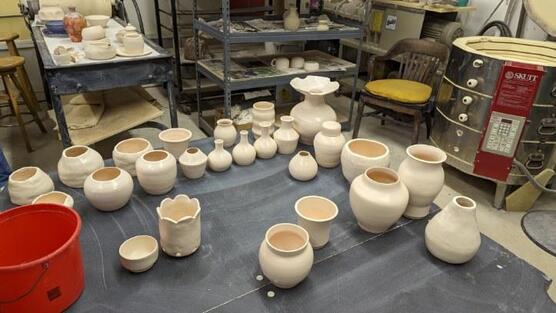student firing
Firing Methods
Several firing techniques are used at the studio besides gas high-fire reduction. One of the students favorites is a raku firing where clay pots are glazed, fired to when the glaze can be seen to melt, pulled out of the kiln and placed in metal garbage cans where newspaper or sawdust has been added with lids closing the cans. This forms a reducing atmosphere decreasing the oxygen inside the enclosed can and causing the glaze to form colors on the pots. After the pots cool, around 30 minutes, they are removed from the can and sometimes quenched in water, cleaned and taken home. All within a 3hour time frame! “Instant Gratification”.
Several firing techniques are used at the studio besides gas high-fire reduction. One of the students favorites is a raku firing where clay pots are glazed, fired to when the glaze can be seen to melt, pulled out of the kiln and placed in metal garbage cans where newspaper or sawdust has been added with lids closing the cans. This forms a reducing atmosphere decreasing the oxygen inside the enclosed can and causing the glaze to form colors on the pots. After the pots cool, around 30 minutes, they are removed from the can and sometimes quenched in water, cleaned and taken home. All within a 3hour time frame! “Instant Gratification”.
Pit Fire
First process includes a grog-free clay with a Terra Sig applied to bone dry clay and fired to cone 018. Secondly, applying wood shavings, corn husks, banana peels, coffee grounds, copper oxide and salt during and after stacking pieces into the pit which are layered with kindling wood, pots and large pieces of wood. Then ignite the fire. After initial start the pit was covered with metal and allowed to burn overnight and two days later opened up for the reveal.
First process includes a grog-free clay with a Terra Sig applied to bone dry clay and fired to cone 018. Secondly, applying wood shavings, corn husks, banana peels, coffee grounds, copper oxide and salt during and after stacking pieces into the pit which are layered with kindling wood, pots and large pieces of wood. Then ignite the fire. After initial start the pit was covered with metal and allowed to burn overnight and two days later opened up for the reveal.
Sagger Firing
Similar to the raku firing is the sagger firing where a pot is drenched in ferric chloride, drained off and enhanced with an application of horse hair, dried coffee grounds, miracle grow, sea weed, copper wire, etc. and are used in combination on the pot wrapped in aluminum foil.
The foil forms a sagger around the pot allowing the added materials to fume the pot.
The pot is fired to around 1350 degrees F, taken out of the kiln cooling to 900 degrees F or less and slowly removing the foil to reveal the colors formed on the pot. A spray of clear sealant is used to enhance and bring out the colors. Spectacular color results often occur very similar to a Pit Firing which takes place at the studio with more advanced level students.
Another technique all within the 3 hour time frame.
Naked Raku
One last technique is naked raku, where the bisque pots are coated with clay slip and placed inside the kiln and heated as in the raku firing. When the pot is removed and placed in the garbage can, the smoke from the burning newspaper enters the cracked slip areas on the pot and forms black areas and lines. Once cool and the pot removed from the garbage can, the clay slip is easily removed exposing a very beautiful surface of not only black and white but shades of gray. Still within the same time frame of 3 hours.

